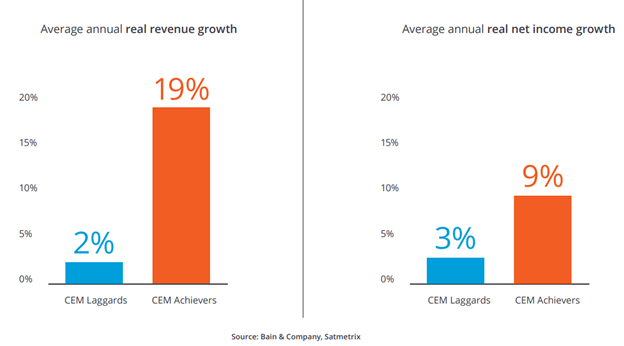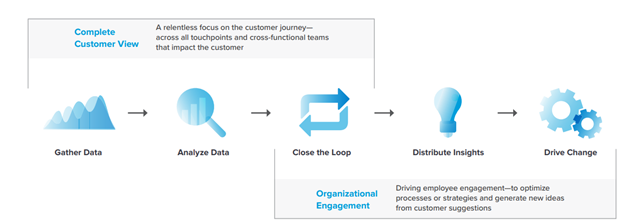Have you ever heard of intentional living? Someone who leads an intentional life lives according to their beliefs and values. And instead of passively allowing circumstances to shape their lives, they act with intent, which Merriam-Webster defines as, "a usually clearly formulated or planned intention."
I think intentional living is a good metaphor for how businesses should approach customer experience (CX). If they truly value customers and believe that exceptional CX is the way to acquire and retain business, companies should follow a "clearly formulated" plan to ensure they deliver consistent, satisfying CX throughout the customer journey.
This requires rigorous customer experience management (CEM). Passively allowing CX to evolve naturally won't work in today's business environment. Demanding consumers and more touchpoints than ever make a strong customer experience management program a must-have for businesses to remain competitive.
What is customer experience management?
Customer experience management is a disciplined approach to understanding and continuously improving the customer journey. Customer data and employee behavior are at the heart of CEM efforts. Customer input is collected from multiple sources and the insights are disseminated across the organization, including front line contact center agents, to drive employee behavior and improve CX.
CEM, also called Voice of the Customer (VOC), is more than just a survey data analysis effort. CEM programs leverage feedback from numerous sources, such as social media posts and customer service interactions, to gain a more holistic understanding of customer opinions and improvement opportunities.
Customer experience management isn't just the contact center’s or CEM team's responsibility. Customer-centricity requires organizational alignment, which means removing silos, fostering cooperation, deploying collaborative tools, and influencing employee behavior.
By generating data-driven customer insights and broadening employee engagement, customer experience management efforts can drive change and improve the customer journey. Ultimately, focusing on and improving CX can result in higher revenue and net income.

Figure 1 Source: NICE Satmetrix: Driving CEM Program Maturity
Basic steps to design and implement your customer experience management program
Since a CEM program is all about using a structured and disciplined approach to improving CX, you should also use a structured approach to designing and implementing your program. This should, at the very least, include the following steps.
1. Secure sponsorship and funding
This is the first step in most major initiatives, and it's particularly important for an effort as far reaching into an organization as a CEM implementation.
CEM initiatives should have an influential executive sponsor. To really align with the customer and improve the customer journey can involve significant organizational change. Multiple processes in multiple departments may be impacted, which will require strong leadership.
Additionally, CEM comes with a price tag. Depending on your design and current technology, you may need to add a headcount and acquire customer experience management software and AI-powered analytics tools. When you present the estimated costs for approval, also include financial benefits such as increased customer lifetime value. Improving CLV is one of the main purposes of focusing on CX!
2. Design and assemble the team
Your implementation team should be cross-functional with representatives from groups such as customer service, marketing, IT, e-commerce, and product development. The team will be responsible for setting goals, designing processes, and selecting software, and serving as liaisons with their own departments. Cross-functionality will help ensure buy-in and that the design decisions consider all necessary stakeholders and enterprise processes.
Ideally, some of your implementation team members would transition to become part of your permanent customer experience management team. The CEM team is responsible for:
- Developing a strategy that achieves the desired customer experience
- Representing the voice of the customer
- Understanding customer insights and analytics
- Creating positive interactions along the customer journey
- Recommending, implementing, and maintaining relevant tools
- Collaborating with other teams throughout the organization
3. Establish customer experience management goals
This is a critical step because the program goals will guide decisions about process designs and technology selection. Start with high-level objectives. For example, maybe you want your CEM program to accomplish the following:
- Provide a deeper understanding of the drivers of customer satisfaction and engagement
- Improve customer loyalty
- Enhance the end-to-end customer journey
- Provide information to make marketing programs more effective
All of these are viable CEM objectives, but they need to be drilled down a level in order to identify measurable KPIs. For example, for the "enhance the end-to-end customer journey" objective, you could measure:
- Net Promoter Score (NPS) - NPS measures your customers' willingness to refer friends and colleagues to your brand and is one of the top CX metrics.
- Customer satisfaction (CSAT) - CSAT surveys measure customer satisfaction with a specific aspect of the business at a certain point in time and are a good way to determine if improvements to specific touchpoints are working.
- Customer effort score - Customer effort score tells you if customers think it's easy or hard to do business with your company, making it an important measure of the customer journey.
For your other high-level objectives, you might also consider measuring:
- Customer lifetime value (CLV) – Customer lifetime value measures how profitable a customer is for the duration of their relationship with a business. Satisfying experiences should influence customers to purchase more products and services and have a longer relationship with the brand, both of which can positively impact the CLV calculation.
- Customer churn rate - Customer churn is a measure of how many customers you lost in a given time period, expressed as a percentage. Because a primary goal of CEM is to keep more customers, customer churn rate should definitely be on your list of KPIs.
Drilling down another level, contact centers have several CX-impacting metrics to track, including:
- Average speed to answer (ASA) - measures the average time customers must wait before they reach an agent.
- First contact resolution (FCR) - the percent of initial contacts that result in a resolved issue.
- Transfer rates - when customers are transferred, it creates friction in their journeys, so contact centers should try to keep transfer rates low.
- Self-service success rates - many customers want to resolve their own issues, but poorly designed self-service solutions can create low success rates and high customer frustration levels.
Spend some time on this step to ensure your customer experience management program is designed for success and can continuously assess and improve CX.
4. Design your customer experience management process
This is the step in which you determine how you're going to analyze and improve CX on an ongoing basis. As an example, let's take a look at the NICE Satmetrix model. (NICE Satmetrix is the co-creator of Net Promoter Score and is the leading expert in CEM.)

Figure 2 Source: NICE Satmetrix: Driving CEM Program Maturity
- Gather data. Because customer experience management is a data-driven approach to improving CX, the first step of the process is to gather as much customer feedback as you can, the more the better. Remember, this doesn't just include survey data, although survey results are important to include. Think of this step as "listening to your customers," which means other sources of information might include:
- Customer service interactions
- Product reviews
- Social media comments and mentions
- Blog posts
- Focus group results
Including multiple data sources will help ensure you're getting a more comprehensive view of CX and help pinpoint places in the customer journey that need improvement.
- Analyze data. Once you gather data, it’s time to analyze it. The analysis step should transform all the data you've collected into insights that help you understand your customers and the opinions they have of your business and the experiences you provide. Ultimately, this step of the process should help you develop strategies to improve CX.
- Close the loop. The analysis step will identify individual customers who are dissatisfied. Someone in your organization should follow up with them and try to close the loop on their issues. This step can help salvage relationships and improve retention. In fact, making things right with disgruntled customers can actually increase loyalty.
- Act on data. Improving the customer experience is an enterprise responsibility. Everything from product packaging to invoice design to website performance impacts CX, so all departments have a role to play. Insights from data analysis should be distributed widely and the customer experience management team should facilitate a collaborative approach to resolving CX issues.
- Drive change. Perhaps the most important step in the process is driving change. A CEM program needs to be the catalyst for making improvements to the customer experience that result in higher loyalty, more revenue, and increased customer satisfaction.
This process is continuous. There will always be new customer input to collect and analyze, new opportunities to collaborate, and new enhancements to make to the customer experience.
5. Select and implement technology
As you can imagine, the level of analysis and collaboration needed to have a successful CEM program requires powerful technical tools. The best CEM software (also called voice of the customer software) integrates and analyzes data from multiple sources to provide a holistic assessment of CX. Additionally, it helps break down silos with effective collaboration tools. Also, look for solutions with these capabilities:
- Real-time view of the customer
- Role-specific charts, dashboards, and reports
- Workflows that facilitate tasks such as closing the loop
- Easily configurable to accommodate your specific CEM program needs
- Easily integrates with other systems
Including these five steps in your implementation plan will help ensure your customer experience management program will succeed in improving the customer experience and business results.
Example of a successful customer experience management initiative
If you're like me, an example always helps to clarify new concepts, so let's take a look at a real-world example of CEM success.
A large, UK-based consumer finance company underwent a digital transformation that resulted in a significant increase in the use of customer self-service. Normally, when more customers use self-service, contact center volume decreases, but in this case, volume remained flat. They didn't have enough insight into the end-to-end customer journey to understand why this was happening, so they initiated a CEM effort to provide more information.
They began by implementing a CEM application in their contact center, but eventually expanded the scope to more channels and five additional customer journey touchpoints. Their data sources have also expanded to include structured customer feedback as well as unprompted input from sources such as text and speech analytics, customer complaint volume, Google analytics, and more. This data gives the company a comprehensive view of CX and allows them to identify pain points that need to be addressed.
Identifying pain points helps the business identify root contact drivers. For example, activating direct debit services could take as long as 56 days, and confusing process steps were generating customer service calls. Improving that process reduced the number of complaints.
This CEM effort resulted in substantial improvements to NPS and customer effort scores. For example, effort scores were improved by as much as 36% during the project. Additionally, complaints per 1000 customers were reduced by 33%, which decreased contact center volume. And because good CEM programs distribute relevant information to front-line employees, the initiative made customer service agents more effective at resolving issues, which boosted agent satisfaction. All these successes resulted in the approval of funding for more CEM efforts.
Get started with implementing your new customer experience management program
Gartner found that two-thirds of companies now compete mostly on the basis of CX, rather than product or price, and that number is expected to increase. Businesses that are true to their customer-centric values and execute CX with intent will be positioned for success. This requires a disciplined CEM approach that uses customer insights and employee engagement to drive CX-enhancing change throughout the organization.
Contact centers are valuable sources of customer information - after all, they talk to your customers all day long. Transforming all those conversations into useful information requires powerful, AI-enabled interaction analytics software. Visit our product page to see how NICE CXone Interaction Analytics can enhance your customer experience management efforts.



